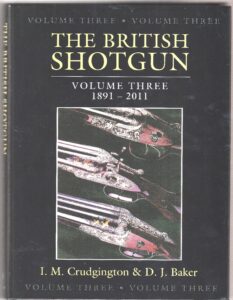
By Ian Crudgington & David Baker
$80 + $5.09 shipping
Available from:
Globepequot.com
1-800-223-2336
Ian Crudgington is one of the best of the Best Quality gunmakers in the British Isles and David Baker is perhaps the best chronicler of the British gun trade. Together they have traced the development of the British shotgun from 1891 to 2011 through the history of the patents on the mechanisms that make up the guns.
The volume is lavishly illustrated with clear patent drawings showing the evolution and development of the different gun mechanisms along with great photos of the finished guns giving a clear picture from a gunmaker’s perspective. This is not something that can be properly done by someone outside the trade and no one is better qualified than Crudgington to do it.
The book begins with the development of the single trigger for double shotguns with clear drawings sufficient for anyone in the trade to follow. Next is a chapter on the over-and-under gun’s development showing the design of the different guns. This is followed by a chapter on the machine-made single barrel guns.
The American designs that gave rise to this type of gun are given full credit and the many subsequent British variations from hammerless models to shotgun versions of the military Martini rifle are shown. It made me wish that I could still order a 12-gauge military Martini complete with ramrod under the barrel and bayonet from the Midland Gun Company in 1938. These required the barrel at an angle to the breech allowing you to load the long 12-gauge shell and look straight down the barrel from the opened breech, something you cannot do with the military rifle version.
Next is the part dear to me. The continuing development of the side by side shotgun with all the innovative designs from the Best Quality gunmakers who made the side-by-side game gun the longest lasting and easiest and surest shotgun to hit with possible. There is far more mechanical variation among the gunmakers and their guns than meets the eye and it is all here in clear easy to understand drawings and photos of some of the most exquisite guns ever made.
Guns that deviate from the standard format are covered in the chapter “Guns of Aberrant Form,” which covers everything from the Churchill 25-inch barrel guns to 3-barrel guns to double-barreled repeaters. Now there’s something you don’t see every day.
The book goes on with a chapter on the various ejectors and another chapter on the different designs for safety catches finally concluding with a chapter on the “Aids to Shooting” detailing some of the innovative ideas and devices developed over the years in an effort to help the shooter.
This book gives the reader a clearer picture of just how the guns in the British gun trade really work than any other book that I have seen. Knowing the authors, it is just what I would expect. For anyone wanting a clearer understanding of the finest shotguns ever made this book is a necessity.—Jim Dickson


